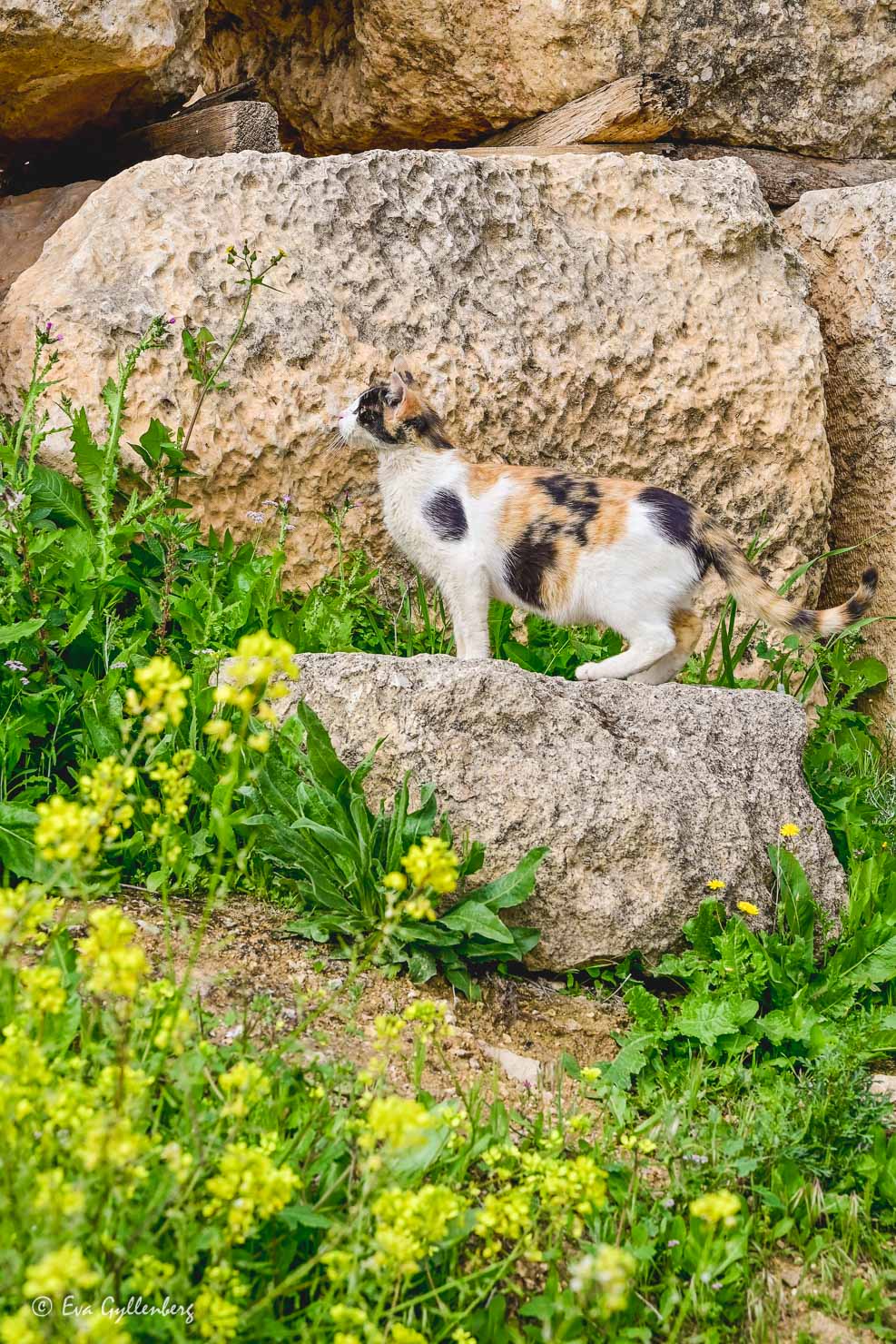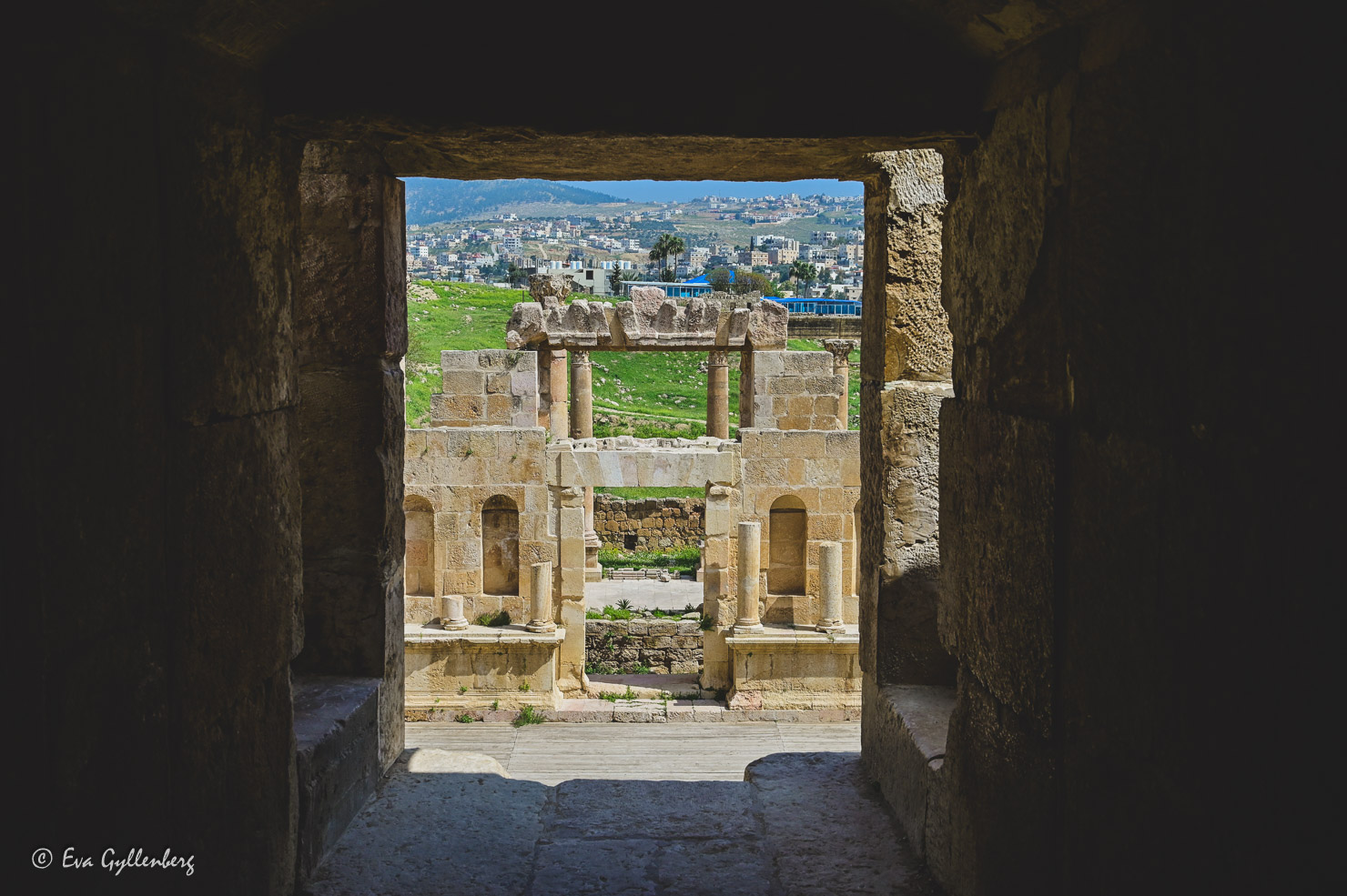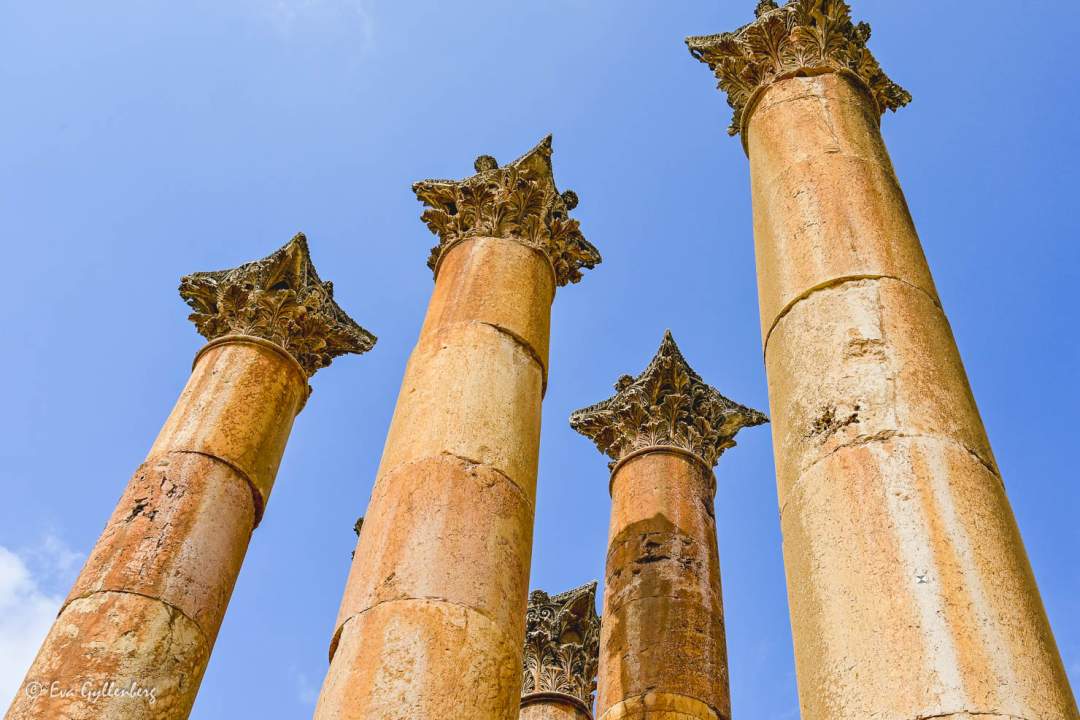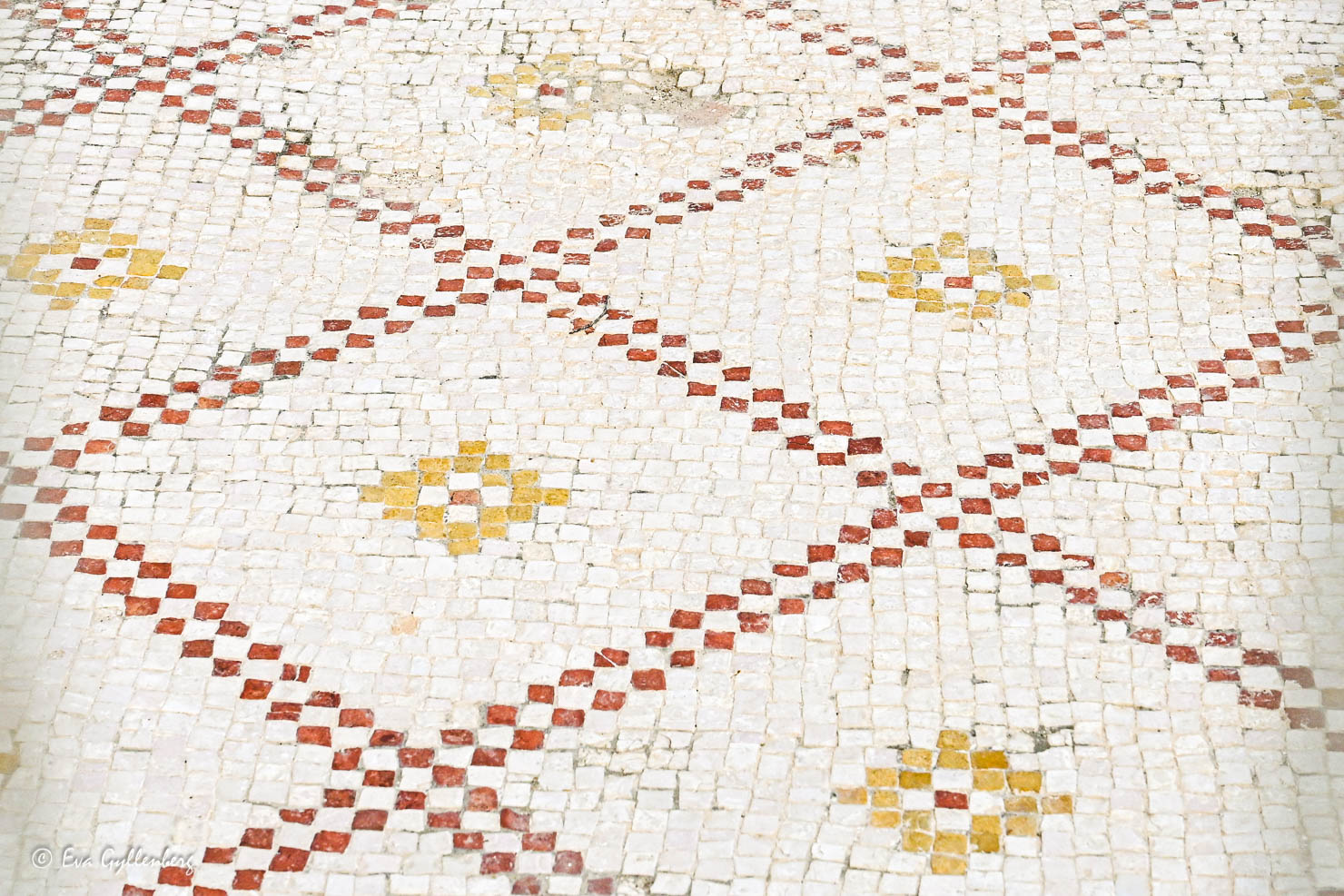Besöket i Jerash gjordes under en pressresa tillsammans med Jordan Tourism Board och Royal Jordanian Airlines, men alla tankar och åsikter är som vanligt mina egna.
Djupa skåror i de nötta gatustenarna under mina fötter berättar om hästar med tungt lastade vagnar som under hundratals år rullat här. Jag står i staden Jerash, en forna knutpunkt mellan Mellanösterns två stora handelsvägar. Staden som under romarriket hade ett överflöd av rikedom och bekvämligheter, men där allt förstördes över en natt i en katastrofal jordbävning.

Välbevarade Gerasa
Staden Gerasa (numera Jerash) i norra Jordanien är en av världens bäst bevarade romerska städer utanför Italien. Även om det mesta av staden idag är i ruiner, är det inte svårt att föreställa sig stadens forna storhet. Varenda sten håller så mycket historia att det är svårt att ta in alla intryck från det vidsträckta området. De väldekorerade stenkolonnerna vid stadens tempel reser sig fortfarande mot himlen, akustiken i den södra teatern är fortfarande perfekt och mosaikgolven är lika vackra som de var för 1000 år sedan.


Tusentals år av historia
Stadens historia började redan på stenåldern. I ett område med gott om tillgång till bördig mark och vatten växte en mindre stad fram.
Under 200-talet före Kristus påbörjade Alexander den Store utvecklingen av den stad som kom att bli det Jerash som vi ser resterna av idag. När romarna sedan erövrade området år 63 före Kristus blev Jerash en viktig provinsstad för hela romarrikets handel och en av Mellanösterns viktigaste handelsstäder. En stad full av vackra byggnader och rikedom, intet ont anande den annalkande katastrofen.

Jerash jordbävning och fall
Jerash kallas ibland för Mellanösterns Pompei, på grund av en katastrofal jordbävning år 749. Jordbävningen var enorm och förstörde städer i ett stort område i nuvarande Israel och Jordanien. Människor blev begravda under de raserade husen och de få invånare som överlevde katastrofen lämnade staden.
För Jerash kom jordbävningen att innebära början till slutet. Inga byggnader kom att återuppbyggas och området täcktes av sand och glömdes bort tills utgrävningar påbörjades under 1900-talet.

För arkeologer är Jerash en svår stad att utforska och bara en bråkdel av området har hittills grävts ut. Bronsålderns byggnader revs av grekerna och grekernas byggnader revs av romarna. Hela staden består av lager på lager av årtusenden och civilisationer och det ligger antagligen mer historia under det skal vi ser idag, men det är svårt att undersöka det som ligger under ytan utan att förstöra något. Som besökare är dock de synliga ruinerna mer än nog för att uppleva den imponerande staden.
Hadrianus båge och hippodromen
Det första mötet med staden är oftast via den imponerande Hadrianus båge, en triumfbåge som byggdes i stadens södra utkant kring år 130 till äran av besöket av den romerske kejsaren Hadrianus. Det här är en av romarrikets största triumfbågar och byggnaden visar än idag upp välbevarade dekorelement av blomsterslingor och blad. Idag står bågen rätt ensam, men ursprungligen var tanken att detta skulle vara stadens huvudingång omgiven av murar. Det blev aldrig någon mur, men det är fortfarande en imponerande byggnad att passera igenom på väg in i staden.


Bredvid Hadrianus båge ligger den forna hippodromen, där vilda hästkapplöpningar och gladiatorspel utspelade sig under romartiden. I romerska mått är det en liten arena för 15.000 människor, ”bara” 245 meter lång och 45 meter bred. Arenan används än idag för skådespel och hästuppvisningar.


Ovala plazan
Vi går norrut och ser snart den ovala plazan omgiven av hoplänkade kolonner som erbjudit täckta gångar runt torget. Det här var stadens centrum, en gång i tiden en plats för handelsmän, statyer och till och med en fontän.
Den ovala plazan är ett pampigt torg, omgiven av 56 höga pelare. Här länkades huvudvägen ihop med trappan upp till Zeus tempel och det är även från templet som du får bäst vy över plazan.


Zeus tempel
Zeus tempel ligger som en övervakande beskyddare på en kulle ovanför den ovala plazan. Templet byggdes år 162 och var en av stadens mest imponerande byggnader. Det här var ett ovanligt stort romerskt tempel, med ett väldekorerat tak och i sina glansdagar målat i klara färger.
På vägen upp till templet passerar man förbi åtskilliga stenblock med reliefer av blommor, frukter, mönster och blad. Stenar som varit en del av templet innan de började plockas ned på 500-talet för att återanvänds för en bysantinsk kyrka.



De två teatrarna
Ljudet av Amazing grace på säckpipa studsar mellan den södra teaterns väggar. Att mötas av säckpipor i Jordanien kanske låter konstigt, men säckpipan blev ett instrument i den jordanska armén under första halvan av 1900-talet då området var ett brittiskt protektorat.
Den södra teatern är den största teatern i Jerash och under dess glansdagar kunde upp till 5000 personer sitta här på läktaren. Här spelades teaterstycken och musik och man har i utgrävningarna hittat biljetter av lera. Ju längre ner på läktaren du hade en plats, desto mer betydelsefull person var du i samhället.
Teatern har en fantastisk akustik och än idag hör du lika bra från den översta raden som den nedersta.



Den norra teatern är inte alls lika stor som den södra teatern och var antagligen inte en plats för nöje, utan en plats där stadens beslutsfattare samlades för råd. Det går än idag att hitta personnamn inristade på specifika platser på läktaren.



Artemis tempel
På en äng av blommande vårblommor ligger Artemistemplet – en av de bäst bevarade byggnaderna i Jerash. Templet var tillägnat gudinnan Artemis som i den grekiska mytologin var jaktens gudinna och moder till allt levande.
Trots sitt utsatta läge för väder och vind står fortfarande 11 pelare med dekorerade kapitäl kvar och vittnar om byggnadens storhetstid för nästan 2000 år sedan. Det är lätt att föreställa sig templets forna prakt med marmor, stora statyer och målat tak.




Huvudgatan Cardo maximus och nymfeum
Som en spikrak linje rakt in i hjärtat av Jerash går Cardo maximus, den 800 meter gamla huvudleden. Gatan kantas av en rad av pelare och har ett avancerat underjordiskt avrinningssystem gömt under gatan.
Längs vägen ligger en av gatans vackraste sevärdheter och ett tecken på områdets rikedom. Stadens nymfeum är imponerande än idag. Här flödade vatten ner över marmorklädda väggar med avsatser med figurer och genom munnarna på stora statyer av lejon. Vattnet samlades in genom avancerade akvedukter och rör och bjöd på en show för stadens besökare. Det här var antagligen platsen där stadens invånare hämtade allt sitt dricksvatten.



Hur besöker man Jerash?
Jerash ligger ungefär en timmes bilfärd norr om Amman. Den romerska staden sträcker sig över ett stort område mitt i den nuvarande staden Jerash.
Jag besökte Jerash under en halv dag tillsammans med en guide, vilket kändes som ett alltför kort besök för att kunna ta del av allt som Jerash har att berätta. Jag skulle rekommendera minst en hel dags besök. Det finns skyltar på engelska på området, men för att få en helhetsbild av staden är det bra med en guide.
De flesta turister som besöker Jerash har köpt Jordan Pass och går in gratis, men det går att köpa inträde på plats (kostade 10-12 JD för turister 2023).

Vill du läsa mer om Jerash?
- Generell information om Jerash på Visit Jordan
- Intressant (mer djupgående) artikel i National Geographics





Tack för ett fint inlägg om Jerash! Vi besökte staden strax innan pandemin och tyckte nog att vid sidan om Petra var Jerash det allra bästa besöksmålet under vår Jordanienresa. Så fina bilder på de mäktiga ruinerna!
Tack snälla du! Jag håller med, Jerash är en av de häftigaste historiska platserna jag besökte i Jordanien! Jag visste ingenting om platsen innan jag kom hit, konstigt att staden inte är mer känd!